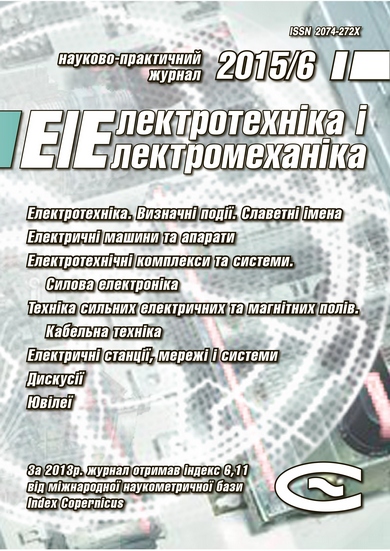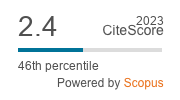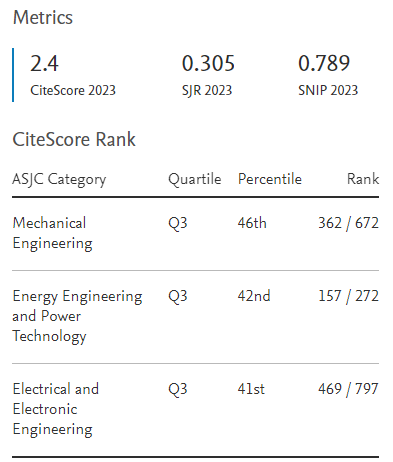MODELING OF EQUIVALENT STIFFNESS OF A MAGNETIC SPRING OF VIBRATION EXCITER BASED ON COAXIAL-LINEAR MOTOR
DOI:
https://doi.org/10.20998/2074-272X.2015.6.03Keywords:
stiffness coefficient, magnetic spring, vibration exciter, coaxial-linear motorAbstract
Purpose. The research of the influence of value and direction of current on the equivalent spring magnetic force based on coaxial-linear motor (CLM – MS). Methodology. We carried out investigation of the equivalent harshness of magnetic spring with determination of electromechanical propulsion performance characteristics by the methods of computer modeling and experimental research of physical model of CLM – MS. The modeling of magnetic spring of CLM – MS is carried out by the finite-element method. The challenge is met as an axisymmetric challenge in cylindrical co-ordinates in magnetostatic approach. The experimental investigattion of the propulsion performance characteristics of magnetic spring is carried out on the test bench. Results. After the computer modeling and the experimental investigation of the electromechanical propulsion performance characteristics of magnetic spring the expressions of equivalent stiffness coefficient depending on the current in winding are obtained. The results of computer modeling are confirmed experimentally. Originality. The determination of equivalent stiffness coefficient of magnetic spring of vibration exciter based on coaxial-linear motor. Practical value. The obtained determination of equivalent stiffness coefficient of magnetic spring may be used in process of designing of vibration machines with devices for change of natural oscillation frequency.References
Martynov V.D., Aleshin N.I., Morozov B.P. Stroitel'nye mashiny i montazhnoe oborudovanie: Uchebnik dlia studentov vuzov po spetsial'nosti «Pod'emno-transportnye, stroitel'nye, dorozhnye mashiny i oborudovanie» [Construction machines and assembly equipment: Textbook for students in specialty «Lifting-and-vehicles, building, road machines and equipment»]. Moscow, Mashinostroenie Publ., 1990. 352 p. (Rus).
Biderman V.L. Teoriia mekhanicheskikh kolebanii: Uchebnik dlia vuzov [Theory of mechanical vibrations: Textbook for universities]. Moscow, Vysshaia shkola Publ., 1980. 408 p. (Rus).
Vibratsii v tekhnike: Spravochnik. V 6-ti tomakh. T.4. Vibratsionnye protsessy i mashiny. Pod red. Lavendela E.E. [Vibration in technique: Handbook in 6 vols. Vol.4. Vibrating processes and machines. Edited by Lavendel E.E.]. Moscow, Mashinostroenie Publ, 1981. 509 p. (Rus).
Bauman V.A., Bykhovskii I.I., Gol'dshtein B.G. Vibratsionnye mashiny v stroitel'stve i proizvodstve stroitel'nykh materialov [Vibrating machines in the construction and production of construction materials]. Moscow, Mashinostroenie Publ, 1969. 544 p. (Rus).
Bohayenko M.V., Bondar R.P., Golenkov G.M., Holub V.P., Makohon S.A., Parkhomenko D.I., Popkov V.S. Vibrozbudzhuvach [Vibration exciter]. Patent UA, no.24757, 2007. (Ukr).
Golenkov G.M., Parkhomenko D.I. The electromechanical propulsion performance characteristics of coaxial-linear motor with constant magnets and magnet bracket. Tekhnichna elektrodynamika – Technical Electrodynamics, 2014, no.6, pp. 56-59. (Ukr).
COMSOL Multiphysics®. The Platform for Physics-Based Modeling and Simulation. Available at: www.comsol.com/comsol-multiphysics (accessed 13 September 2004).
Downloads
Published
How to Cite
Issue
Section
License
Copyright (c) 2015 G. M. Golenkov, D. I. Parkhomenko

This work is licensed under a Creative Commons Attribution-NonCommercial 4.0 International License.
Authors who publish with this journal agree to the following terms:
1. Authors retain copyright and grant the journal right of first publication with the work simultaneously licensed under a Creative Commons Attribution License that allows others to share the work with an acknowledgement of the work's authorship and initial publication in this journal.
2. Authors are able to enter into separate, additional contractual arrangements for the non-exclusive distribution of the journal's published version of the work (e.g., post it to an institutional repository or publish it in a book), with an acknowledgement of its initial publication in this journal.
3. Authors are permitted and encouraged to post their work online (e.g., in institutional repositories or on their website) prior to and during the submission process, as it can lead to productive exchanges, as well as earlier and greater citation of published work.





